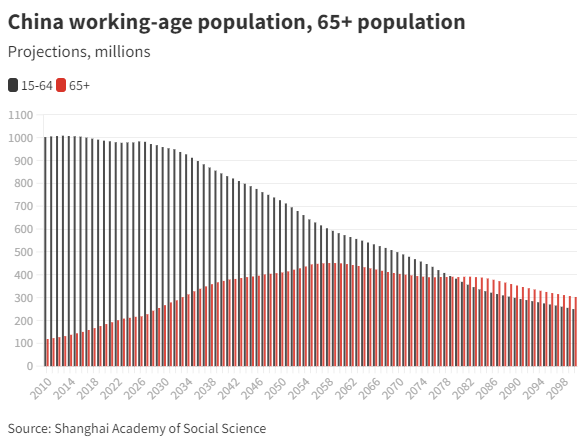China’s population is about to shrink for the first time since the great famine struck 60 years ago. Here's what that means for the world

China's population is on track to turn down this year, for the first time since the great famine of 1959-1961. Image: Unsplash/Ewan Yap
- China's population is on track to decline for the first time since the great famine of 1959-1961
- The country’s total fertility rate decreased from 2.6 in the late 1980s – well above the 2.1 needed to replace deaths – to just 1.15 in 2021.
- Researchers predict China's elderly population will overtake its working-age population around 2080.
- Decreases in the number of working-age people will lead to much lower economic growth and higher labour costs as the population shifts to care for its elderly.
The world’s biggest nation is about to shrink.
China accounts for more than one sixth of the world’s population.
Yet after four extraordinary decades in which China’s population has swelled from 660 million to 1.4 billion, its population is on track to turn down this year, for the first time since the great famine of 1959-1961.
According to the latest figures from China’s National Bureau of Statistics, China’s population grew from 1.41212 billion to just 1.41260 billion in 2021 – a record low increase of just 480,000, a mere fraction of the annual growth of eight million or so common a decade ago.
While a reluctance to have children in the face of strict anti-COVID measures might have contributed to the slowdown in births, it has been coming for years.
China’s total fertility rate (births per woman) was 2.6 in the late 1980s – well above the 2.1 needed to replace deaths. It has been between 1.6 and 1.7 since 1994, and slipped to 1.3 in 2020 and just 1.15 in 2021.
By way of comparison, in Australia and the United States the total fertility rate is 1.6 births per woman. In ageing Japan it is 1.3.
This has happened despite China abandoning its one-child policy in 2016 and introducing a three-child policy, backed by tax and other incentives, last year.
Theories differ about why Chinese women remain reluctant to have children in the face of state incentives. One involves having become used to small families, another involves the rising cost of living, another involves increasing marriage age, which delay births and the dampens the desire to have children.
In addition, China has fewer women of child-bearing age than might be expected. Limited to having only one child since 1980, many couples opted for a boy, lifting the sex at birth ratio from 106 boys for every 100 girls (the ratio in most of the rest of the world) to 120, and in some provinces to 130.
China's population shrinking on reasonable assumptions
China’s total population grew by a post-famine low of just 0.34 in 1,000 last year.
Projections prepared by a team at the Shanghai Academy of Social Sciences have it falling this year – for the first time post-famine – by 0.49 in a thousand.
The turning point has come a decade sooner than expected.
As recently as 2019 the China Academy of Social Sciences expected the population to peak in 2029, at 1.44 billion.
The 2019 United Nations Population Prospects report expected the peak later still, in 2031-32, at 1.46 billion.
The Shanghai Academy of Social Sciences team predicts an annual average decline of 1.1% after 2021, pushing China’s population down to 587 million in 2100, less than half of what it is today.
The reasonable assumptions behind that prediction are that China’s total fertility rate slips from 1.15 to 1.1 between now and 2030, and remains there until 2100.

The rapid decline in China's population will have a profound impact on the country's economy.
China’s working-age population peaked in 2014 and is projected to shrink to less than one third of that peak by 2100.
China’s elderly population (aged 65 and above) is expected to continue to climb for most of that time, passing China’s working-age population near 2080.
What is the World Economic Forum doing to accelerate value-based health care?
Older, and much less young
This means that while there are currently 100 working-age people available to support every 20 elderly people, by 2100, 100 working-age Chinese will have to support as many as 120 elderly Chinese.

The annual average decline of 1.73% in China’s working-age population sets the scene for much lower economic growth, unless productivity advances rapidly.
Higher labour costs, driven by the rapidly shrinking labour force, are set to push low-margin, labour-intensive manufacturing out of China to labour-abundant countries such as Vietnam, Bangladesh and India.
Already manufacturing labour costs in China are twice as high as in Vietnam.
More caring, less manufacturing
At the same time, China will be required to direct more of its productive resources to provision of health, medical and aged-care services to meet the demands of an increasingly elderly population.
Modelling by the Centre of Policy Studies at Victoria University suggests that without changes to China’s pension system, its pension payments will grow five-fold from 4% of GDP in 2020 to 20% of GDP in 2100.
For resource-exporting nations such as Australia, these changes are likely to require a reorientation of exports towards manufacturers outside China.
For importers of goods including the United States, the source of goods is set to gradually shift towards new and emerging centres of manufacturing.
Despite forecasts that this will be “the Chinese century”, China's population projections suggest influence might move elsewhere – including to neighbouring India, whose population is expected to overtake China within this coming decade.
Don't miss any update on this topic
Create a free account and access your personalized content collection with our latest publications and analyses.
License and Republishing
World Economic Forum articles may be republished in accordance with the Creative Commons Attribution-NonCommercial-NoDerivatives 4.0 International Public License, and in accordance with our Terms of Use.
The views expressed in this article are those of the author alone and not the World Economic Forum.
Stay up to date:
China
Forum Stories newsletter
Bringing you weekly curated insights and analysis on the global issues that matter.
More on Geographies in DepthSee all
Naoko Tochibayashi
October 30, 2025






